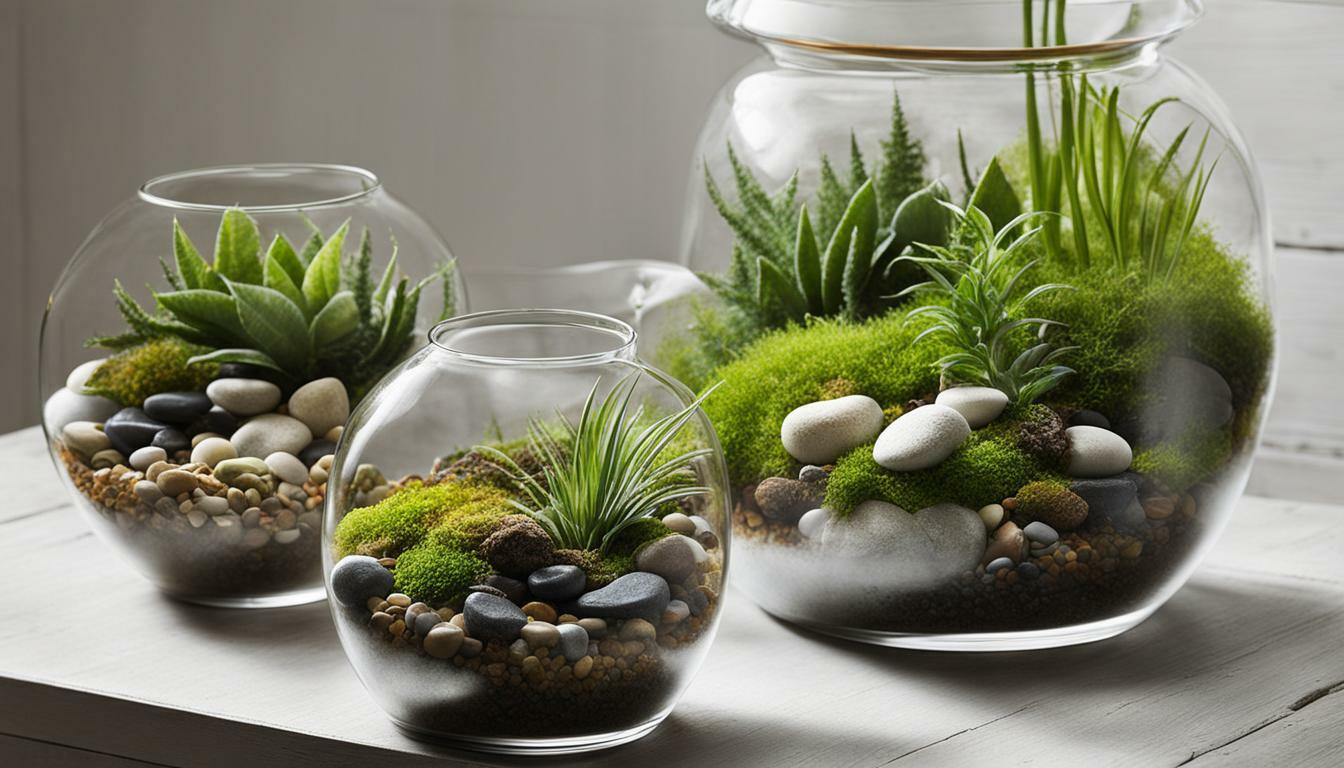Looking for creative ways to display terrariums in your home or office? Discover unique ideas that will enhance your space with vibrant and eco-friendly décor options.
If you’re looking to add a touch of greenery to your living or workspace, terrariums are the perfect solution. Not only do they bring the beauty of nature indoors, but they also serve as eye-catching decorative pieces. From tiny terrariums in small glass containers to themed terrariums that transport you to different settings, there are endless possibilities to explore.
Key Takeaways:
- Create tiny terrariums using small glass containers like spice jars or vials.
- Consider moss terrariums for a lush and vibrant display.
- Experiment with sand art terrariums for stunning works of art.
- Use native materials to create a natural and foraged look.
- Opt for open terrariums with cacti and succulents for a visually striking style.
Tiny Terrariums in Small Glass Containers
Want to add a touch of greenery to your mantelpiece or worktop? Consider creating tiny terrariums using small glass containers like spice jars or vials, and fill them with moss or small plant cuttings. These miniature terrariums are not only visually appealing but also easy to maintain, making them perfect for both home and office spaces.
With their compact size, spice jars or vials can be placed in any corner of your space, adding a refreshing touch of nature. The clear glass allows you to fully admire the vibrant greens and intricate details within the terrarium. You can experiment with different shapes and sizes of containers to create a visually pleasing display.
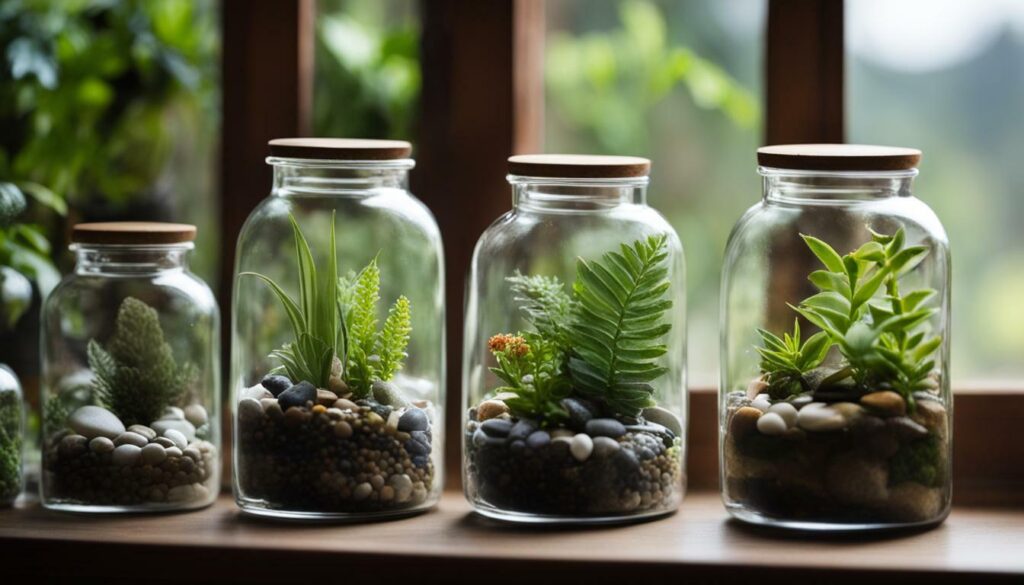
To create your tiny terrarium, start by adding a layer of gravel or pebbles at the bottom of the container for drainage. Then, layer some activated charcoal to help keep the terrarium fresh and prevent any unpleasant odors. Next, add a thin layer of soil suitable for the plants you have chosen. Gently position the moss or small plant cuttings in the soil, arranging them in an aesthetically pleasing way. Finally, mist the terrarium with water to provide the necessary moisture.
These miniature terrariums can be placed individually on mantelpieces or worktops, or grouped together to create a stunning display. Not only do they bring a touch of nature into your space, but they also serve as a conversation starter. So why not get creative and start crafting your very own tiny terrariums today?
Moss Terrariums
If you’re looking to create a captivating and low-maintenance terrarium, consider focusing on moss as the main element to create a lush and vibrant display. Moss terrariums have become increasingly popular due to their simplicity and natural beauty. They bring a touch of nature indoors and require minimal care, making them perfect for busy individuals or those who may not have a green thumb.
Moss terrariums can be created in various containers, from glass jars to fish tanks or even old glass light bulbs. The possibilities are endless, allowing you to get creative with the design and structure of your terrarium. Once you have a container, layer the bottom with small rocks or gravel to provide proper drainage.
| Materials needed: | Instructions: |
|---|---|
| Glass container | 1. Choose a suitable container for your moss terrarium, ensuring it has adequate drainage. |
| Small rocks or gravel | 2. Layer the bottom of the container with small rocks or gravel to provide drainage. |
| Sphagnum moss or sheet moss | 3. Add a layer of sphagnum moss or sheet moss on top of the rocks to prevent soil from mixing with the drainage layer. |
| Potting soil or terrarium soil mix | 4. Add a layer of potting soil or terrarium soil mix on top of the moss to create a growing medium for the moss. |
| Assorted moss varieties | 5. Place different varieties of moss on top of the soil, arranging them in a visually appealing manner. |
| Decorative elements (optional) | 6. Add decorative elements like small figurines, rocks, or twigs to enhance the overall aesthetic of your moss terrarium. |
| Water spray bottle | 7. Mist the moss lightly with water using a spray bottle, ensuring it remains moist but not overly wet. |
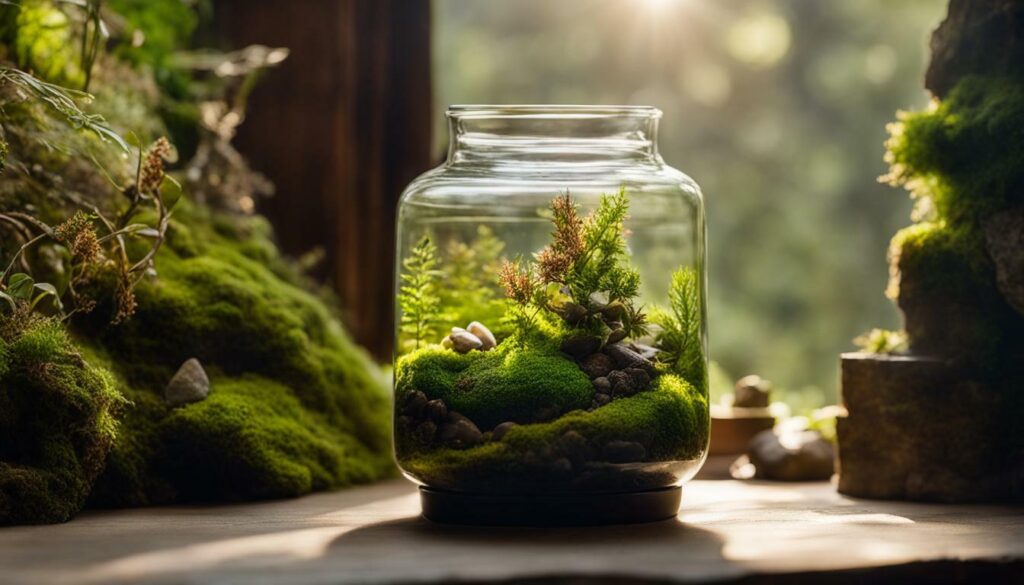
“Adding a few drops of water to the terrarium once every two to four weeks is usually sufficient to maintain the moisture levels.”
Maintaining a moss terrarium is relatively simple. Moss thrives in a moist environment but does not require frequent watering. Adding a few drops of water to the terrarium once every two to four weeks is usually sufficient to maintain the moisture levels. It’s important to monitor the moisture content and avoid overwatering, as this can lead to mold or rot.
Moss terrariums make for beautiful centerpiece displays on coffee tables or can be placed on windowsills to add a touch of greenery to any space. Their vibrant green color and soft texture create a soothing and inviting atmosphere. With proper care, your moss terrarium will continue to flourish and provide a captivating, low-maintenance display in your home or office.
Sand Art Terrariums
Looking to add a unique and visually stunning touch to your terrarium? Try creating a sand art terrarium, where layers of different colored sand create mesmerizing works of art. These sand art terrariums are a beautiful way to bring color and creativity into your terrarium displays, making them stand out from the crowd.
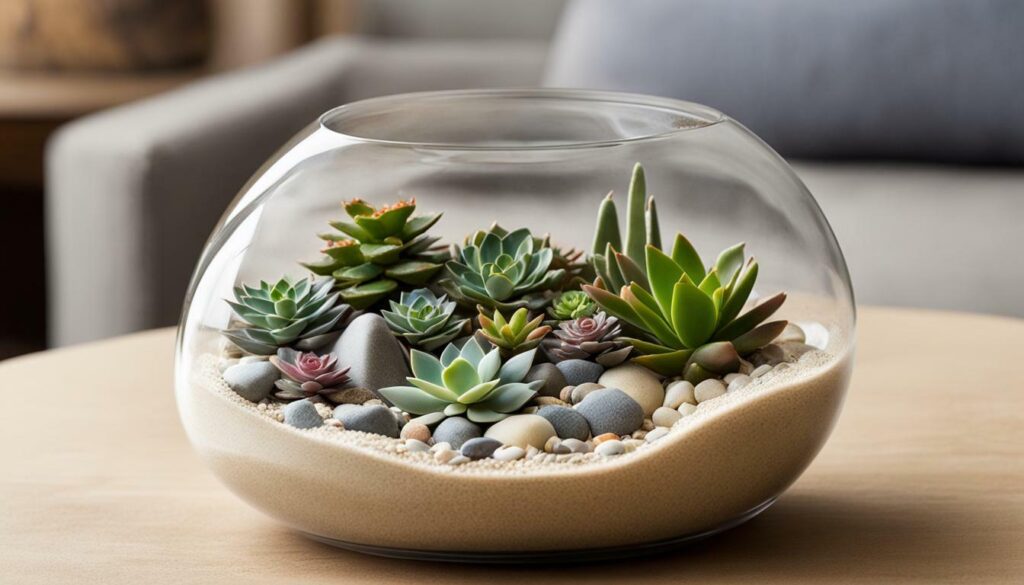
With sand art terrariums, the possibilities are endless. You can experiment with different colors and patterns, creating intricate designs that resemble miniature landscapes. The layers of colored sand add depth and texture to your terrarium, making it a true work of art.
To create a sand art terrarium, start by selecting a clear glass container that allows for visibility of the vibrant layers. Begin layering the sand colors of your choice, using a spoon or funnel to ensure an even distribution. You can create patterns, gradients, or even incorporate shapes or symbols into your design.
| Materials | Instructions |
|---|---|
| Clear glass container | Select a clear glass container that allows for visibility of the sand art layers. |
| Colored sand | Choose an assortment of colored sand to create your desired design. |
| Spoon or funnel | Use a spoon or funnel to layer the sand colors evenly within the container. |
Sand art terrariums are not only visually appealing but also a great way to express your creativity. They make for stunning centerpieces or conversation starters in both home and office environments. So why not give it a try and turn your terrarium into a captivating work of art?
Native Terrariums
For a terrarium that reflects the beauty of your local environment, consider creating a native terrarium using foraged materials like glass jars, gravel, charcoal, and moss. Native terrariums allow you to bring a piece of nature indoors while showcasing the unique elements of your surroundings. They provide a sense of connection to your local environment and can be a great conversation starter.
To start, find a suitable glass jar or container that will serve as the base for your terrarium. This could be a mason jar, a vintage glass bottle, or even a repurposed fish tank. The idea is to use a container that not only holds the elements of your terrarium but also adds to its aesthetic appeal.
Once you have your container, gather materials such as gravel, which will serve as a drainage layer, and activated charcoal, which helps filter the air and water within the terrarium. Next, collect moss from your surroundings. Moss not only adds a natural touch to your terrarium but also helps retain moisture and provides a soft, cushion-like bed for your plants.
| Materials you will need: |
|---|
| Glass jar or container |
| Gravel |
| Activated charcoal |
| Moss |
Once you have all your materials, it’s time to assemble your native terrarium. Start by adding a layer of gravel at the bottom of the container, ensuring proper drainage. Next, sprinkle a thin layer of activated charcoal over the gravel. This will help keep the terrarium clean and fresh by filtering out impurities. Finally, arrange your collected moss on top of the charcoal, creating a soft and natural bed.
With your foundation set, you can now add small native plants or succulents to your terrarium. Choose plants that thrive in your local environment, as they will be better adapted to the conditions within the enclosed space. Native ferns, mini orchids, or small evergreen plants can add a touch of greenery and natural beauty to your terrarium.
Remember to water your terrarium sparingly, as the enclosed environment will naturally retain moisture. Place it in a location with indirect sunlight, as too much direct sunlight can create excessive heat and damage the plants. With proper care and attention, your native terrarium will become a living work of art, bringing the beauty of your local environment into your home or office.
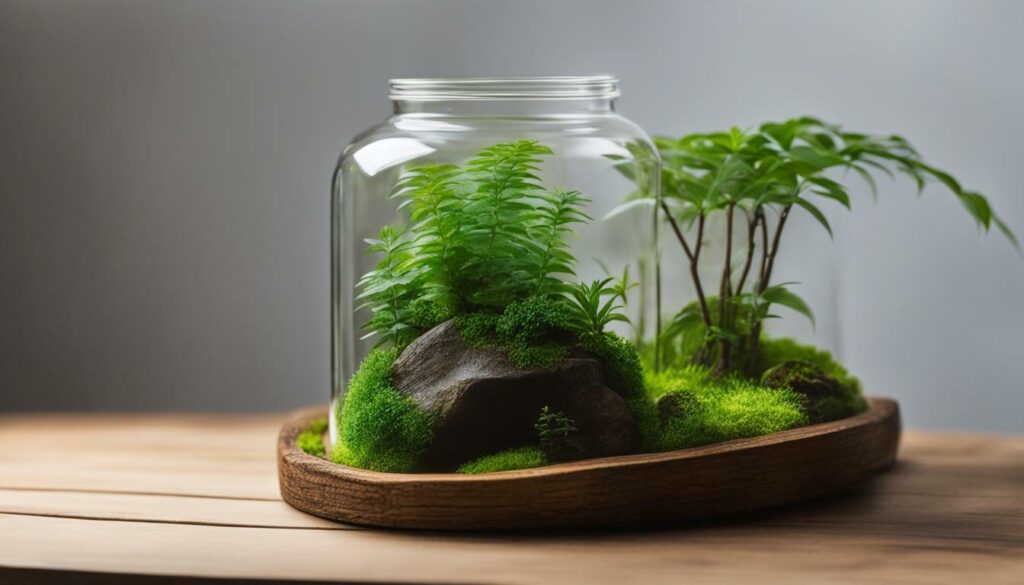
Looking for a terrarium that stands out with its distinctive style? Consider creating an open terrarium featuring cacti and succulents for a visually striking display. Open terrariums are a unique twist on the traditional closed terrariums, offering a different aesthetic and allowing for more airflow. By incorporating cacti and succulents, you can create a desert-inspired oasis that is both low-maintenance and visually appealing.
Cacti and succulents are known for their ability to thrive in arid conditions, making them the perfect choice for open terrariums. Their unique shapes, textures, and colors add interest and variety to the display, creating a visually stunning arrangement. From spiky cacti to plump succulents, there is a wide range of options to choose from, allowing you to create a terrarium that reflects your personal style and taste.
To create an open terrarium with cacti and succulents, start by selecting a suitable container. Opt for a shallow container with good drainage to prevent water from pooling and causing root rot. Layer the bottom with a mixture of cactus soil and sand to provide a well-draining environment. Arrange the cacti and succulents in the soil, considering their size and growth habits. You can also add decorative elements like rocks or pebbles to enhance the overall aesthetic.
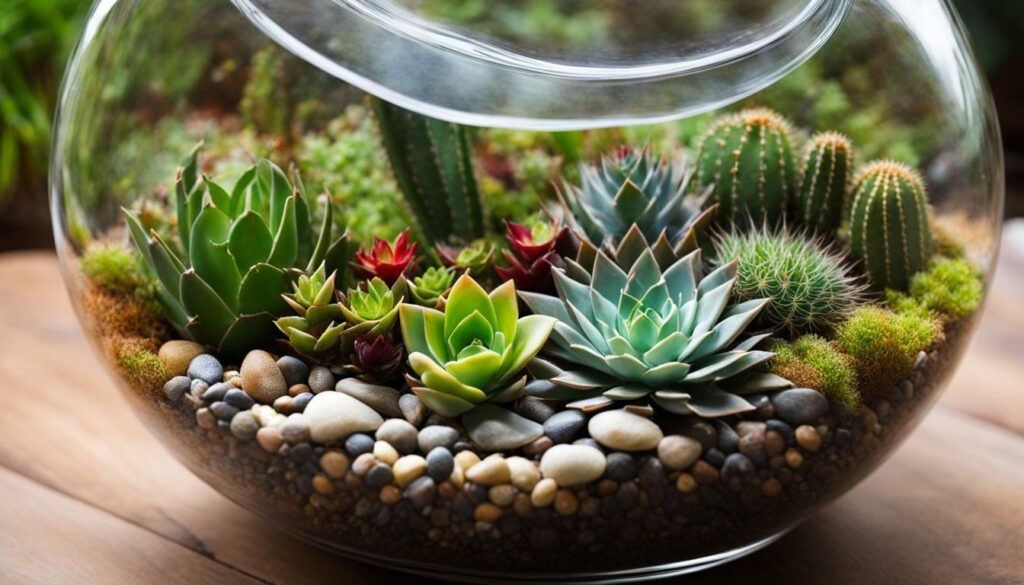
- Low maintenance: Cacti and succulents are known for their ability to tolerate drought and require minimal watering.
- Visually striking: The unique shapes, textures, and colors of cacti and succulents create a visually appealing display.
- Distinctive style: Open terrariums offer a different aesthetic compared to closed terrariums, adding a touch of uniqueness to your space.
Overall, open terrariums with cacti and succulents provide a beautiful and low-maintenance option for adding greenery to your home or office. The combination of desert-inspired plants and the open-air environment creates a visually striking display that is sure to catch the eye. So why not give it a try and create your own open terrarium with cacti and succulents?
Herb Terrariums
Looking to combine aesthetics with functionality? Herb terrariums offer a practical opportunity to grow your own herbs while adding a touch of greenery to your space. Whether you have a small apartment or a spacious office, herb terrariums can fit beautifully in any setting.
With herb terrariums, you have the convenience of having fresh herbs readily available for your culinary endeavors. Imagine plucking a few sprigs of basil or mint from your own miniature garden as you prepare a delicious meal. Not only do herb terrariums provide a sustainable and cost-effective solution for herb cultivation, but they also serve as visually pleasing decorations.
To create a herb terrarium, start by selecting a glass container that allows for air circulation and easy access to your plants. Fill the bottom with some gravel or pebbles to provide drainage, then layer in some potting soil. Choose your favorite herbs such as rosemary, thyme, or parsley, and plant them in the soil, leaving enough space for growth. Finally, give them a good watering and place your terrarium in an area with ample sunlight.
Tips for Maintaining Herb Terrariums:
- Water sparingly: Overwatering can lead to root rot, so make sure the soil is moist but not soaked.
- Monitor sunlight: Most herbs need at least 6-8 hours of sunlight per day, so find a spot that provides adequate light.
- Trim regularly: Prune your herbs to encourage healthy growth and prevent them from becoming too leggy.
- Fertilize occasionally: Use a balanced liquid fertilizer to provide essential nutrients to your herbs.
| Herb | Light Requirements | Watering Frequency | Harvesting Time |
|---|---|---|---|
| Basil | 6-8 hours of direct sunlight | Water when the top inch of soil is dry | Harvest when the plant has at least 6 leaves |
| Mint | Partial shade to full sun | Keep the soil consistently moist | Harvest sprigs as needed |
| Parsley | Partial shade to full sun | Water when the top inch of soil is dry | Harvest outer leaves as needed |
| Thyme | 6-8 hours of direct sunlight | Water when the top inch of soil is dry | Harvest sprigs as needed |
With herb terrariums, you can enjoy the satisfaction of growing your own herbs while adding beauty and freshness to your living or working space. So why not embark on a journey to create your very own herb terrarium today?
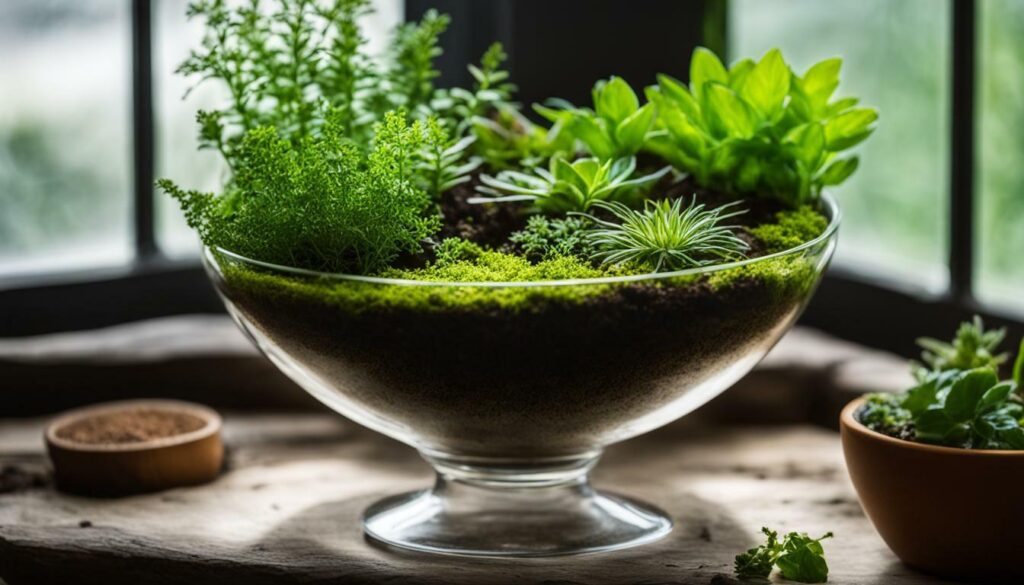
If you’re considering adding some life to your terrarium, it’s essential to choose animals that are suitable for the enclosed space and fulfill their specific requirements. Terrariums can provide a unique and beautiful habitat for a variety of small animals, but it’s important to select species that will thrive in this controlled environment. Here are a few options to consider:
- Snails: These slow-moving creatures are a great addition to a terrarium. They are low maintenance and can help keep the terrarium clean by consuming decaying plant matter.
- Frogs: Certain species of small frogs, such as dart frogs, can thrive in a well-designed terrarium. These colorful amphibians require a humid environment and have specific dietary needs, so research is crucial before adding them to your terrarium.
- Lizards: Some small lizards, like anoles or geckos, can do well in a terrarium setup. They require proper heat, lighting, and a suitable substrate to mimic their natural habitat. Additionally, they need space to climb and hide.
- Arachnids: Tarantulas and scorpions are fascinating creatures that can be housed in a terrarium. These arachnids need a warm and dry environment with minimal disturbances. They require specific substrate and hiding spots to feel secure.
Remember, before adding any animal to your terrarium, it’s important to research their specific care requirements and ensure that you can meet their needs. Providing appropriate food, water, lighting, and temperature control is crucial for the health and well-being of the animals. Additionally, ensure that the terrarium is escape-proof and that the animals are not harmful to each other.
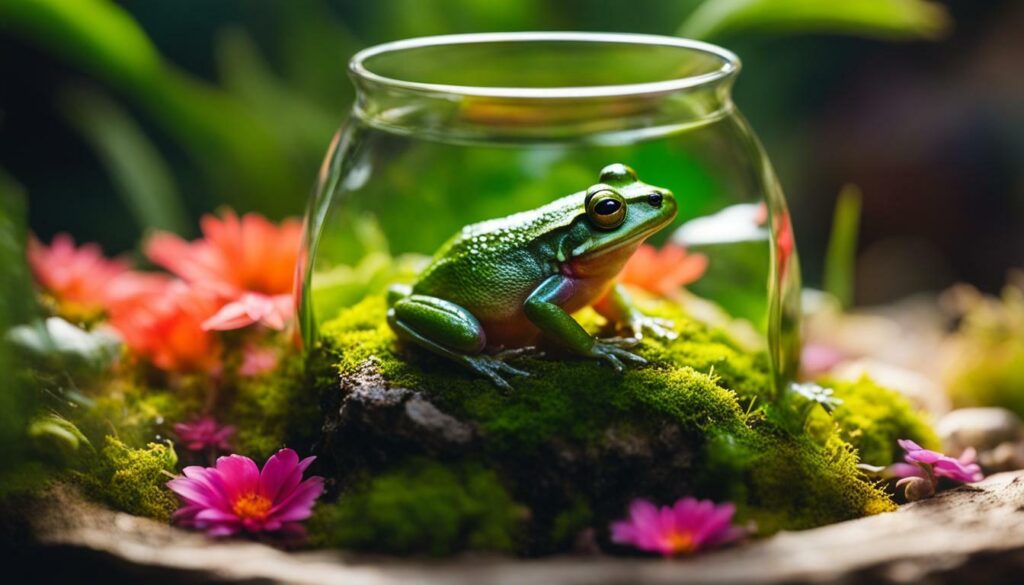
Incorporating animals into your terrarium can add a whole new level of interest and enjoyment. However, always prioritize the well-being of the animals and create an environment that closely mimics their natural habitat. With careful consideration and research, your terrarium can become a thriving ecosystem that houses both plants and animals, creating a captivating display for your home or office.
| Animal | Key Requirements |
|---|---|
| Snails | Moist environment, ample food source, suitable substrate |
| Frogs | Humid environment, correct temperature and lighting, appropriate diet |
| Lizards | Proper heat and lighting, suitable substrate, climbing and hiding spots |
| Arachnids | Warm and dry environment, specific substrate, hiding spots |
Creative Containers for Terrariums
Why limit yourself to traditional containers? Get creative with your terrarium display by using unique options like repurposed light bulbs or clear coffee cups. Not only do these unconventional containers add a touch of whimsy to your terrarium, but they also make for interesting conversation starters.
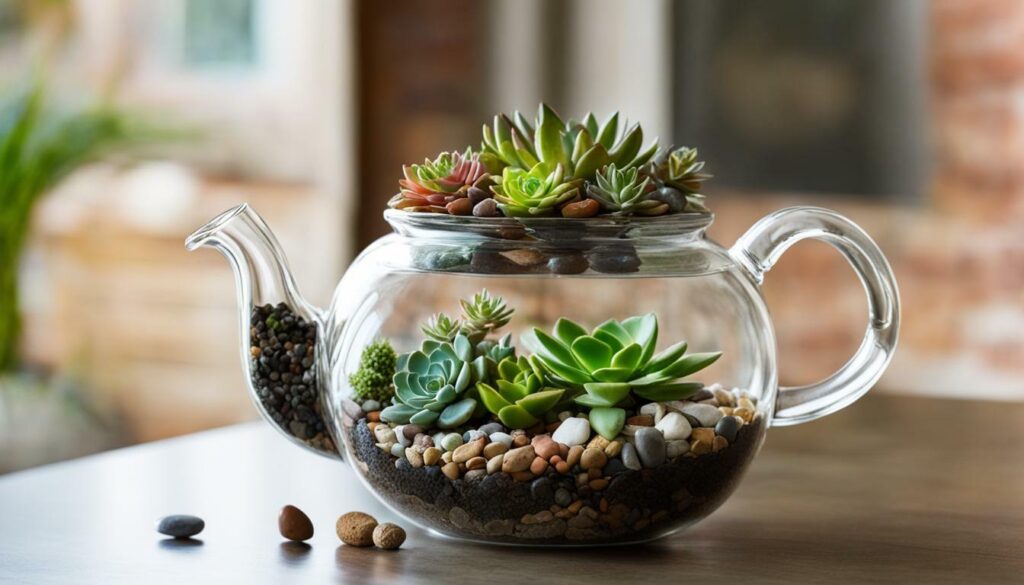
Light bulbs are a popular choice for terrarium enthusiasts looking to create a modern and minimalist display. By removing the internal components and carefully filling the bulb with soil, moss, or small plants, you can transform an ordinary light bulb into a miniature ecosystem. Hang multiple light bulb terrariums at varying heights to create an eye-catching display.
If you prefer a container with a bit more transparency, clear coffee cups offer a unique and modern twist. These cups allow you to showcase the intricate details of your terrarium, while still providing adequate space for the plants to grow. Clear coffee cups can be placed on desks, shelves, or windowsills, adding a touch of greenery to any space.
When choosing creative containers for your terrarium, make sure they are clean and free of any chemicals that could harm the plants. Additionally, consider the size and shape of the container to ensure it provides enough space for the plants to thrive. With a little creativity and a willingness to think outside the box, you can create a truly unique and captivating terrarium display.
Themed Terrariums
Take your terrarium display to the next level by creating themed terrariums, like a miniature beach complete with palm trees and seashells, or a lush jungle with ferns and tiny animals. Themed terrariums offer a unique opportunity to showcase your creativity and create a captivating focal point in any room.
For a beach-themed terrarium, start with a clear glass container and fill it with sand to create a soft, sandy base. Add miniature palm trees to mimic the coastal landscape and place seashells and small pebbles to represent the shoreline. The result is a serene and tranquil beach scene that brings a touch of summer to your space.
If you prefer a more adventurous theme, consider creating a jungle-inspired terrarium. Use a glass container with a lid to create a humid environment, perfect for plants like ferns that thrive in moisture. Add lush greenery, such as moss, ferns, and small tropical plants, to recreate the dense foliage of a jungle. Finally, introduce miniature animal figurines like monkeys or elephants to complete the immersive experience.
| Beach Terrarium | Jungle Terrarium |
|---|---|
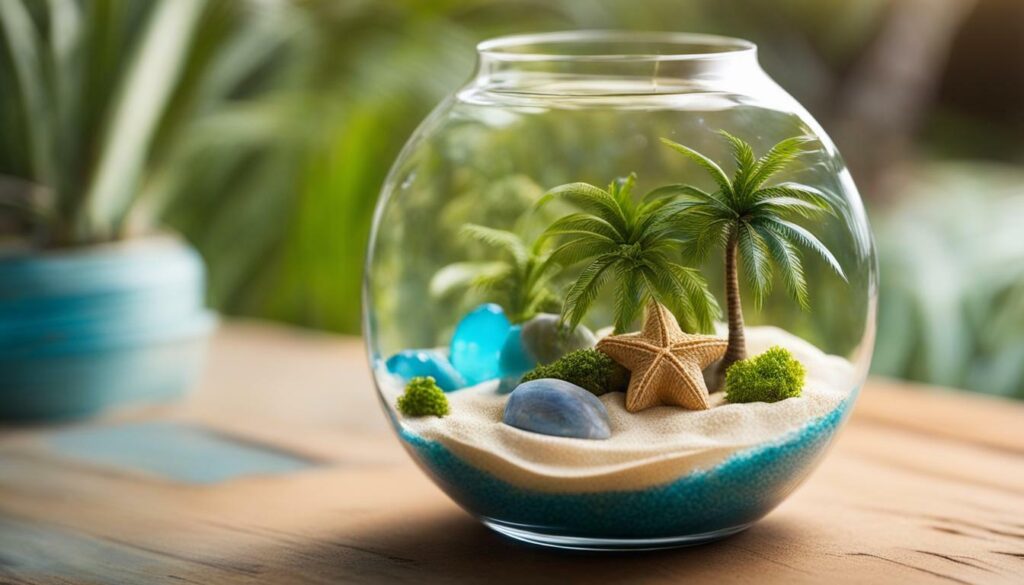 | 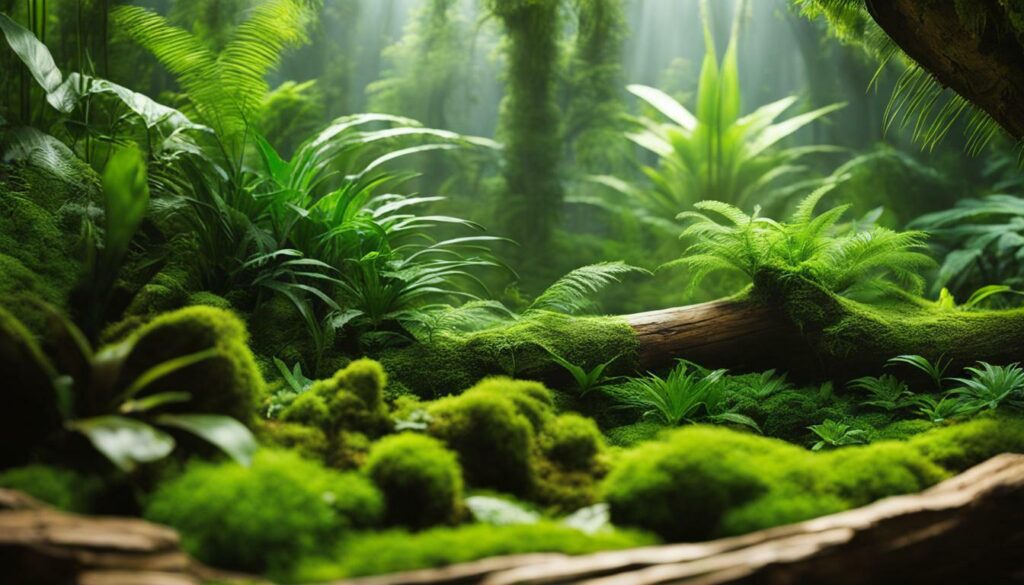 |
Themed terrariums allow you to bring a slice of nature into your home or office, creating a visually stunning display that sparks conversation and adds a unique touch to your space. Whether you choose to embark on a beach adventure or explore the depths of a jungle, themed terrariums offer endless possibilities for creativity and personalization.
Conclusion
With these creative terrarium display ideas, you have the opportunity to personalize and beautify your home or office spaces with vibrant and eco-friendly décor options. Whether you choose to create tiny terrariums in small glass containers like spice jars or vials, or opt for a lush moss terrarium, each option offers a unique and visually appealing display.
If you’re looking to add an artistic touch to your terrarium, sand art terrariums are a great choice. By layering different colored sands, you can create stunning works of art within the terrarium. Alternatively, for a more natural and foraged look, consider using materials from your surroundings to create a native terrarium.
Open terrariums with cacti and succulents provide a visually striking option, while herb terrariums offer a practical opportunity to grow your own herbs. If you’re a nature lover, why not incorporate animals into your terrarium? Just remember to choose animals that are suitable for the enclosed space and meet their specific requirements.
Get creative with the container itself by using unique options like light bulbs or clear coffee cups. And if you’re looking to create a themed terrarium, the possibilities are endless. Whether it’s a beach terrarium with miniature palm trees and shells, or a jungle terrarium with lush ferns and miniature animals, themed terrariums can transport you to a whole new world.
So go ahead, let your creativity bloom and transform your home or office with these inspiring terrarium display ideas. With their vibrant and eco-friendly appeal, terrariums are sure to add a touch of nature and beauty to any space.
How Can I Incorporate Succulent Terrariums into my Home and Office Displays?
Looking to add some greenery to your home or office? Try incorporating vibrant succulent terrarium tips to your displays. These low-maintenance plants can thrive in a variety of environments and can add a pop of color to any space. Create your own mini landscape and enjoy the beauty of succulents.
FAQ
Are terrariums suitable for both home and office spaces?
Yes, terrariums can be a great addition to both home and office spaces, adding a touch of nature and vibrant décor.
What are some creative terrarium display ideas for small spaces?
Creating tiny terrariums using small glass containers like spice jars or vials is a great option for small spaces. These can be placed on mantelpieces or worktops and filled with moss or small plant cuttings.
How can I create a lush and vibrant moss terrarium?
To create a moss terrarium, focus on using moss as the main element. This will transform the terrarium into a lush and vibrant display.
What are sand art terrariums?
Sand art terrariums are terrariums where layers of different colored sand create beautiful works of art within the container.
How can I create a native terrarium using materials from my surroundings?
To create a native terrarium, use glass jars, gravel, charcoal, and moss gathered from your surroundings. This will give your terrarium a natural and foraged look.
Are there any specific plants suitable for open terrariums?
Open terrariums with cacti and succulents are visually striking and offer a different style. These plants are well-suited for open terrariums.
Can I use terrariums to grow my own herbs?
Yes, herb terrariums provide a practical opportunity to grow your own herbs, making it easy to have fresh herbs at your fingertips.
Can I incorporate animals into my terrarium?
Yes, you can incorporate animals into your terrarium, but it’s important to choose animals that are suitable for the enclosed space and meet their specific requirements.
What are some creative container options for terrariums?
Get creative with the container itself by using unique options like light bulbs or clear coffee cups. This will add a unique touch to your terrarium display.
How can I create themed terrariums?
You can create themed terrariums like a beach terrarium with miniature palm trees and shells or a jungle terrarium with lush ferns and miniature animals. Let your imagination run wild!

